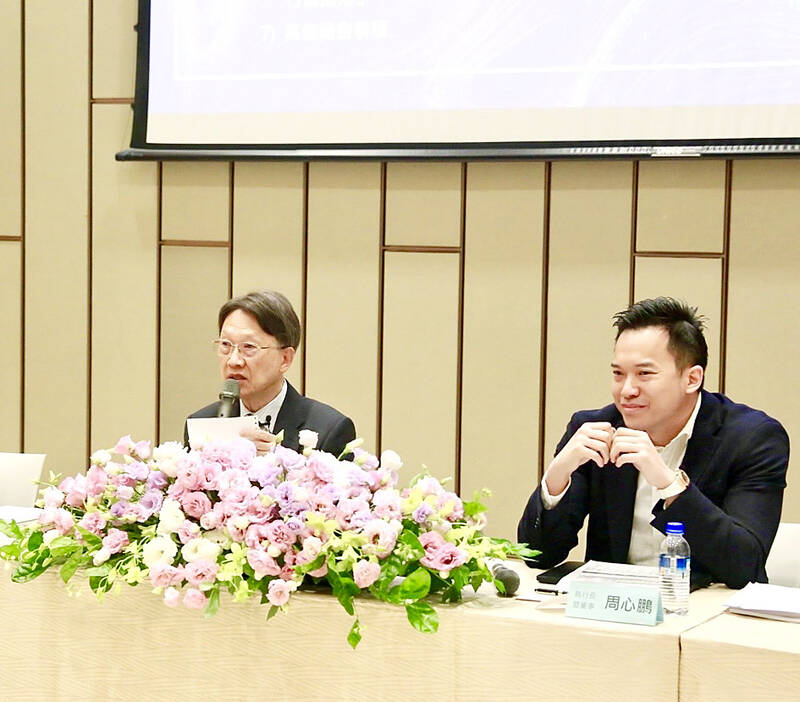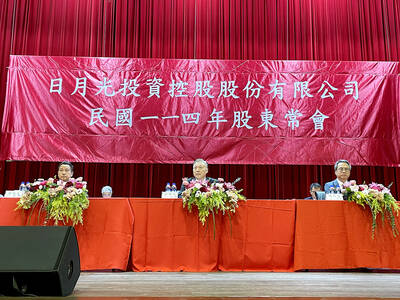Apparel maker Makalot Industrial Co (聚陽實業) yesterday gave a conservative outlook for the company’s business in the second half of this year, as brand clients remain on the sidelines following US President Donald Trump’s tariff policy announcement early last month.
The company also faces potential earnings erosion amid the New Taiwan dollar’s fast appreciation against the US dollar this year, Makalot chairman Frank Chou (周理平) told an annual general meeting in Taipei.
With an order decline expected in the second half of the year, the company would slow down its capacity expansion, while employing flexible capacity allocation and pricing strategy to respond to market changes, and secure as many orders as possible to maintain its market share and steady its factory utilization, he said.

Photo courtesy of Makalot Industrial Co
Makalot, a manufacturer of ready-to-wear garments and functional sportswear products, counts GAP Inc, Fast Retailing Co’s GU sub-brand, Kohl’s Corp, Target Corp, Walmart Inc and Dick’s Sporting Goods Inc among its major clients.
In the first quarter, net profit grew 13.55 percent year-on-year to NT$1.28 billion (US$42.5 million), or earnings per share of NT$5.15, while revenue rose 15.29 percent to NT$9.92 billion from a year earlier.
The firm operates overseas production bases in China, Vietnam, Indonesia, Bangladesh, Cambodia, the Philippines, Guatemala and El Salvador.
However, Trump’s tariffs hit the company’s major overseas bases, with rates of 46 percent for Vietnam, 49 percent for Cambodia, 37 percent for Bangladesh and 32 percent for Indonesia.
Makalot said it would keep its business plans unchanged for new production lines in Bangladesh and El Salvador, while adjusting operations at its plants in Indonesia and Vietnam pending the development of order intake.
As all clients are waiting for the Trump administration’s final tariffs, which might become clearer in early July, the company is conservative about its order outlook for the second half of the year, Makalot CEO Chou Hsin-peng (周心鵬) said.
Despite Trump’s three-month suspension of his tariffs on major trading partners, the implementation of a 10 percent base tariff on all countries still has an impact on end-market demand, he said.
The company has negotiated the 10 percent tariff sharing with major clients, aiming to absorb less than 1 percent of tariff costs on average and no more than 5 percent at the most, he added.
However, the NT dollar’s appreciation against the greenback this quarter is weighing on the company’s earnings, with every 1 percent appreciation in the local currency affecting its operating profit by roughly NT$10 million, or 0.2 percent, Makalot said.
The company has used natural hedging and foreign exchange forward contracts to reduce the impact of exchange rate fluctuations and ensure its operational stability, it said.
Shareholders yesterday approved a company proposal to pay a cash dividend of NT$17.1 per share, the highest ever.
Makalot posted record net profit of NT$4.17 billion last year, up 3.39 percent from a year earlier, or earnings per share of NT$16.68. Revenue in the year increased 9.44 percent year-on-year to NT$35.52 billion.

Greek tourism student Katerina quit within a month of starting work at a five-star hotel in Halkidiki, one of the country’s top destinations, because she said conditions were so dire. Beyond the bad pay, the 22-year-old said that her working and living conditions were “miserable and unacceptable.” Millions holiday in Greece every year, but its vital tourism industry is finding it harder and harder to recruit Greeks to look after them. “I was asked to work in any department of the hotel where there was a need, from service to cleaning,” said Katerina, a tourism and marketing student, who would

i Gasoline and diesel prices at fuel stations are this week to rise NT$0.1 per liter, as tensions in the Middle East pushed crude oil prices higher last week, CPC Corp, Taiwan (台灣中油) and Formosa Petrochemical Corp (台塑石化) said yesterday. International crude oil prices last week rose for the third consecutive week due to an escalating conflict between Israel and Iran, as the market is concerned that the situation in the Middle East might affect crude oil supply, CPC and Formosa said in separate statements. Front-month Brent crude oil futures — the international oil benchmark — rose 3.75 percent to settle at US$77.01

Merida Industry Co (美利達) has seen signs of recovery in the US and European markets this year, as customers are gradually depleting their inventories, the bicycle maker told shareholders yesterday. Given robust growth in new orders at its Taiwanese factory, coupled with its subsidiaries’ improving performance, Merida said it remains confident about the bicycle market’s prospects and expects steady growth in its core business this year. CAUTION ON CHINA However, the company must handle the Chinese market with great caution, as sales of road bikes there have declined significantly, affecting its revenue and profitability, Merida said in a statement, adding that it would

UNCERTAINTIES: The world’s biggest chip packager and tester is closely monitoring the US’ tariff policy before making any capacity adjustments, a company official said ASE Technology Holding Inc (日月光投控), the world’s biggest chip packager and tester, yesterday said it is cautiously evaluating new advanced packaging capacity expansion in the US in response to customers’ requests amid uncertainties about the US’ tariff policy. Compared with its semiconductor peers, ASE has been relatively prudent about building new capacity in the US. However, the company is adjusting its global manufacturing footprint expansion after US President Donald Trump announced “reciprocal” tariffs in April, and new import duties targeting semiconductors and other items that are vital to national security. ASE subsidiary Siliconware Precision Industries Co (SPIL, 矽品精密) is participating in Nvidia